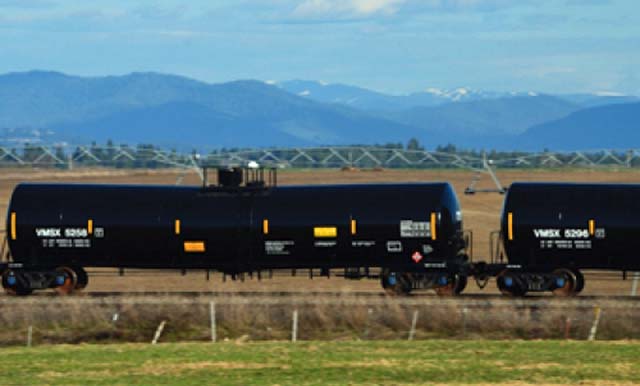|


Canadian crude bound for California moved south through Coeur d'Alene Junction, Idaho, USA, in July aboard Valero tank cars being
handled in a Union Pacific manifest - Date unknown Bruce Kelly.
16 August 2013
CP and UP Forge Canada-to-California CBR Corridor
Coeur d'Alene Idaho USA - For the past year, BNSF Railway has dominated in the shipment of Crude By Rail (CBR) from North America's
Bakken shale formation westward to refineries and ship terminals along America's Pacific Coast. Now, Canadian Pacific and Union Pacific are teaming up to move
crude oil from Canada south into California.
Sporadic shipments were on the increase during summer 2013, with blocks of loaded oil tank cars rolling southward in manifests through the CP/UP interchange at
Eastport, Idaho. Two California refineries are now making preparations to receive 100-car unit trains of Canadian crude from CP and UP, pending approval and
construction of expanded off-loading facilities.
This CP/UP partnership would bring a considerable southward shift to the prevailing flow of CBR across the Western landscape. BNSF began delivering unit oil
trains from North Dakota to a Tesoro refinery at Anacortes, Washington, during summer 2012. Within months, BNSF added unit train shipments to U.S. Oil and
Refining at Tacoma, Washington, and to a storage and trans-loading terminal run by Global Partners and served by short line Portland & Western near
Clatskanie, Oregon. Some, if not all, of the oil shipped to Clatskanie has originated on CP. Additional unit oil train facilities have been proposed in western
Washington by companies including BP, Shell, and Phillips 66.
California, meanwhile, has existing refineries that historically have received the majority of their crude by ship or pipeline. One notable exception was the
unit tank train service introduced in 1983 to move crude from Saco, California, to a refinery at Carson (in the Los Angeles/Long Beach harbor area) via
trackage now owned by Union Pacific. Today, UP instead ships California crude from San Ardo south along the coast to Carson. BNSF is a more recent player in
California's CBR, delivering unit oil trains to the Kern Oil refinery outside Bakersfield. Some of those shipments have involved Bakken crude, which BNSF hauls
west to Washington, then south through Oregon into California.
Now comes Valero Energy, whose refineries at Wilmington and Benicia, California, are slated for track expansion that would handle increased rail volume, up to
60,000 additional barrels per day at Wilmington, and 70,000 barrels per day at Benicia. Valero says rail deliveries of Canadian crude would offset the more
costly crude that currently arrives at these refineries via marine vessel from Alaska and overseas sources.
In March 2013, Bill Day, Valero's Vice President-Media and Community Relations, told the San Antonio Express-News that Valero's Wilmington, California, plant
"now processes a small amount of Canadian crude." Rail shipments of Canadian crude to Wilmington have increased during the summer. As for Valero's
more northerly California refinery, Bill Day tells Railway Age, "Construction has not started yet, so there are no crude by rail deliveries to Benicia at
this time." To further allay public concerns about Canadian "tar sands" oil being processed at Benicia, Day says, "I can confirm that
neither the Valero Benicia Refinery nor the proposed crude by rail off-loading facility there are set up to handle heavy Canadian crude."
CP and UP did not comment on their involvement in crude shipments to California. However, CP spokesman Ed Greenberg did share statements that were made during
a July conference call with analysts, in which Jane O'Hagen, CP's Executive Vice President and Chief Marketing Officer said, "Our crude by rail model
continues to expand with growth momentum built on the expansion of our loading network, diversification of the destination network for optionality, and on the
commitments of our customers to capital."
Recent narrowing of the cost differentials between crude-by-rail and pipeline, as well as between domestic crude and foreign crude, has so far produced less
impact on CBR in the West than it has elsewhere. However, the start of Canada-to-California CBR comes at a time when oil companies are considering new
"rail-to-barge" terminals in western Washington. These would transfer crude from trains to marine vessels for final distribution to refineries up and
down the West Coast, on a larger scale than what's already done through the Clatskanie, Oregon, terminal. Considering the delays that have hampered approval
for Northwest coal ports, and the sheer cost and time to construct a new rail-to-barge oil port, the shipment of Canadian crude by rail to California is a
solid solution, at least for the near term.
Bruce Kelly.



Vancouver Island
British Columbia
Canada
|


